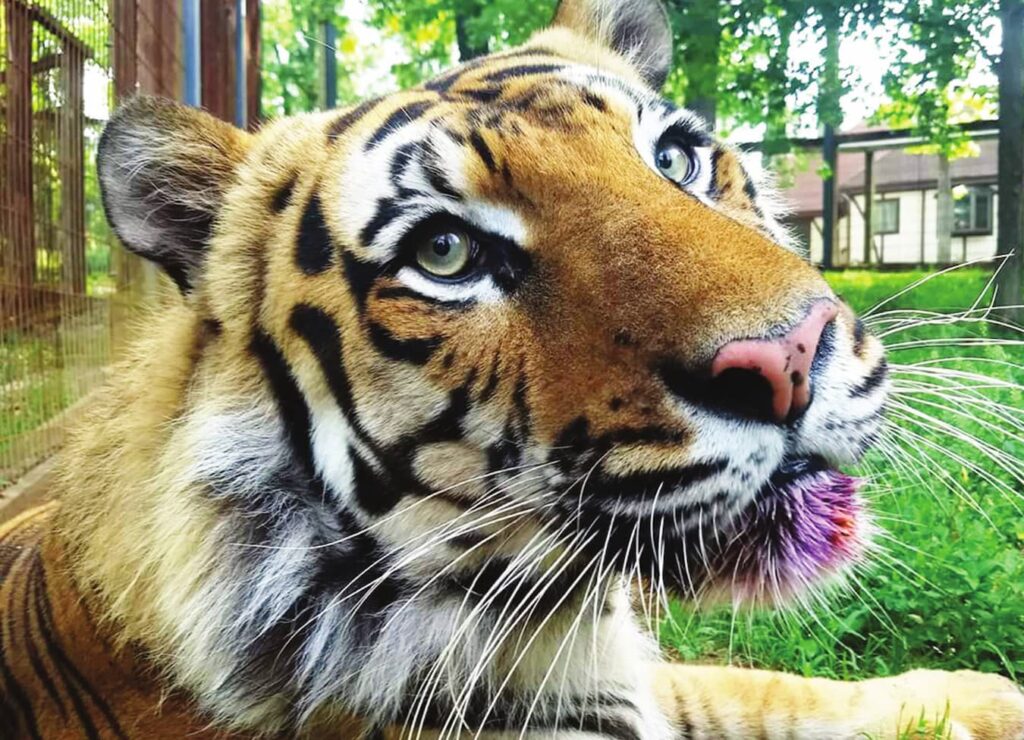In Ste. Genevieve, Crown Ridge Tiger Sanctuary is committed to providing exceptional care to abused and neglected big cats. Fans of these beautiful beasts can tour the facility to learn more about its mission and how the tigers are cared for.

By Pamela Clifton
Izzy likes to be the center of attention. He paints and plays and makes a lot of noise. He even has a root beer—called the Fizzy Izzy—named after him. As an entertainer, Izzy is no lightweight. In fact, he weighs 479 pounds.

Photo courtesy of Crown Ridge Tiger Sanctuary
Izzy is a Siberian tiger who lives at Crown Ridge Tiger Sanctuary, a nonprofit big-cat rescue facility in Ste. Genevieve, Missouri, opened in 2006 by the Scott Foundation. The sanctuary is a licensed USDA home for abused, neglected, and unwanted big cats. Crown Ridge strives to maintain the animals’ integrity by providing exceptional physical and mental care. The sanctuary does not buy, sell, trade, or breed the cats. The staff works with other facilities to provide care for the wild animals.
“Our mission is to give our cats a voice by serving as a leader in wild cat conservation and education,” says John Madian, operation manager, who has been with the organization for six years. He loves his job because it’s like no other, he says. He enjoys the daily variety of tasks—cleaning, yardwork, website work, marketing, leading tours, planning events, building new platforms, or even processing meat for the tigers’ meals.
“I really look forward to coming to work every day,” he says.
John works with Crown Ridge Program Manager Lynn Molden and a few interns. The small staff cares for 11-year-old Izzy and his “sisters” Gracie and Thor, 300-pound Bengal cats. Each tiger has a different yard, or play area, but sometimes Gracie and Thor are together. They were held in captivity together and were neglected and fed very little. As a result, Gracie’s vision was damaged. She now has limited sight in both eyes.
Like their domestic counterparts, these cats sleep a lot—about 14 hours a day. They are most active in the early morning or late evening, and are more vocal at night. They sometimes roar or “talk” to each other. Izzy and Gracie are the most vocal; Thor is quieter and more reserved.
Year-round tours offer guests a chance to see the cats interacting with each other, exploring in their yards, or doing enrichment. Izzy periodically paw paints canvases. The red paint is his favorite, which sometimes distracts him. He enjoys the scent and licks the nontoxic paint from his paws when his creative work is complete.
An education center is the last stop during a tiger tour. Visitors can see a real pelt and replica claws and teeth and view a memory wall, photos, and video. Guests can also adopt a cat and receive monthly updates, or they can purchase Izzy’s paintings or root beer.
Visit CrownRidgeTigers.com for more information.
Article originally published in the March/April 2019 issue of Missouri Life.
Related Posts
From Dragons to Pandas: Animals Aglow Takes the St. Louis Zoo by Storm
Experience the magic of an Animals Aglow adventure at the Saint Louis Zoo! Over 60 dazzling Chinese lanterns illuminate pathways and showcase wildlife and Chinese culture. Interactive displays, cultural opportunities, and Asian delicacies await!
Missouri History Today November 9, 1861: Stars and Stripes: From Civil War Bloomfield to World War II London
Missouri History Today November 9, 1861: Stars and Stripes: From Civil War Bloomfield to World War II London
Stars and Stripe Forever
The enduring military publication Stars and Stripes was born in Bloomfield amid the destruction of the Civil War. Visit the Stars and Stripes Museum Library to see the original newspaper, a Huey helicopter, and many other exhibits.
Relics: Stars and Stripes Museum and Library
Since the first Stars and Stripes was printed in Bloomfield in 1861, the Department of Defense designated Bloomfield as the birthplace of the Stars and Stripes newspaper. The Missouri Stars and Stripes was printed only once during the Civil War. It wouldn’t see publication again until World War I, when it was an eight-page weekly. Publication stopped after WWI, then for the first nine months of World War II, it was restarted.




